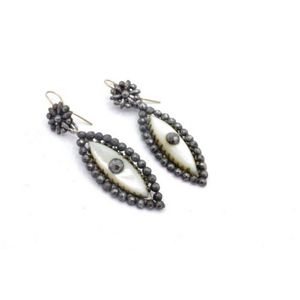Georgian cut steel & mother of pearl drop earrings, rose gold hooks
Georgian cut steel & Mother of pearl drop earrings 'Coque de perle' with later rose gold hooks marked ct, navette 32xmm
You must be a subscriber, and be logged in to view price and dealer details.
Subscribe Now to view actual auction price for this item
When you subscribe, you have the option of setting the currency in which to display prices to $Au, $US, $NZ or Stg.
This item has been sold, and the description, image and price are for reference purposes only.
- Georgian - As an English stylistic period, Georgian is usually taken to cover the period from George I (1714) to the Regency of Prince George (1811-20), although the period from 1800 to 1830 is sometimes designated as the Regency period. During the Georgian period the great English cabinetmakers and designers such as Chippendale, Hepplewhite, Adam Sheraton etc., were all active.
Therefore there isn't a single 'Georgian style' as such and to say something is 'Georgian', usually means it was made between 1714 and 1830. This assumes we discount George V and George VI, both being from the 20th century.
The styles popular at the time of each reign were:
George I (1714-1727) saw out the last years of the Baroque period.
George II (1727-1760) reigned during the Rococo period.
George III (1760-1820) saw the last gasp of the Rococo, all of the early Neo-Classic 'Adam style' and most of the later neo-Classic 'Regency style'.
George IV (Prince Regent 1820-1830)encompassed the last of the 'Regency' style.
William IV's reign (1830-1837) was something of a no man's land (stylistically) and he wasn't a 'George' anyway. He covered the last glimmerings of 'Regency' and the start of the 'Victorian' style. - Carat - A carat (abbreviated "ct") is a unit of measurement used to describe the weight of a diamond or other gemstone, and separately is a unit of measurement used to describe the weight of precious metals such as gold,.
For gemstones, one carat is equal to 0.2 grams or 200 milligrams. The weight of a diamond is one of the Four Cs (along with cut, colour, and clarity) that are used to determine a diamond's value.
It is important to note that a diamond's weight does not necessarily correspond to its size. A diamond's cut, which affects how well it reflects light, can make a diamond of a lower weight appear larger than a diamond of a higher weight. Additionally, the carat is not the only factor to determine the value of a diamond, other factors such as clarity, colour and cut are important too.
In the gold industry, the purity of gold is measured in carats (abbreviated "ct"), with 24 karats being pure gold and lower carat numbers indicating a lower purity level. So, for example, 18 carat gold is 18/24 or 75% pure gold, and 12 carat gold is 12/24 or 50% pure gold. - Cut Steel Decoration - Cut steel decoration is a technique used in the production of jewelry and other decorative items that involves cutting steel pieces into small, faceted shapes and then attaching them to a metal base. These small steel pieces, often called "cut steel beads" are then arranged to form intricate designs, and then attached to a metal base to create a piece of jewelry. This technique was popular in the 18th and 19th centuries, particularly during the Georgian and Victorian eras.
The steel pieces were usually cut with a chisel and hammer, the process was time consuming and labor-intensive, and required a high level of skill. The steel was cut and shaped into small beads or other decorative shapes, and then polished to a high shine. These beads were then strung together or attached to a metal base to create a piece of jewelry or other decorative item.
Cut steel decoration was often used to create jewelry, such as necklaces, bracelets, and earrings, as well as other decorative items, such as buttons and buckles. The jewelry was particularly popular during the Georgian and Victorian eras, as it was considered fashionable and was relatively inexpensive to produce. - Navette - Navette, the French word for (weaver's) shuttle, means shuttle shaped, and is used to describe shapes in jewellery, ceramics and silver.
- Mother-Of-Pearl - Mother-of-pearl, technical name "nacre", is the inner layer of a sea shell. The iridescent colours and strength of this material were widely used in the nineteenth century as an inlay in jewellery, furniture, (especially papier mache furniture) and musical instruments.
In the early 1900s it was used to make pearl buttons. Mother-of-pearl is a soft material that is easily cut or engraved.
Nowadays it is a by-product of the oyster, freshwater pearl mussel and abalone industries.
This item has been included into following indexes:
-
earrings, gold
- gold and diamond drop / pendant 3,185
- gold with pearls 2,537
